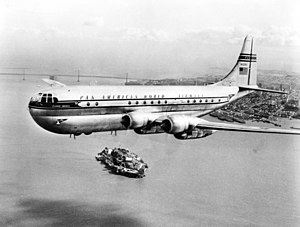
Back بوينغ 377 Arabic Boeing 377 Stratocruiser Czech Boeing 377 German Boeing 377 Spanish بوئینگ ۳۷۷ استراتوکروزر Persian Boeing 377 Finnish Boeing 377 Stratocruiser French Boeing 377 Stratocruiser Frisian Boeing 377 Galician בואינג 377 סטרטוקרוזר HE
| Boeing 377 Stratocruiser | |
|---|---|
 A Pan Am Stratocruiser over San Francisco Bay | |
| General information | |
| Type | Airliner |
| National origin | United States |
| Manufacturer | Boeing Commercial Airplanes |
| Primary user | Pan American World Airways |
| Number built | 56[1][2] |
| History | |
| Introduction date | April 1, 1949, with Pan American World Airways |
| First flight | July 8, 1947 |
| Retired | 1963 |
| Developed from | Boeing C-97 Stratofreighter |
| Variants | Aero Spacelines Pregnant Guppy Aero Spacelines Super Guppy Aero Spacelines Mini Guppy |
The Boeing 377 Stratocruiser was a large long-range airliner developed from the C-97 Stratofreighter military transport, itself a derivative of the B-29 Superfortress. The Stratocruiser's first flight was on July 8, 1947.[3] Its design was advanced for its day; its relatively innovative features (though neither completely new) included two passenger decks and a pressurized cabin. It could carry up to 100 passengers on the main deck plus 14 in the lower deck lounge; typical seating was for 63 or 84 passengers or 28 berthed and five seated passengers.
The Stratocruiser was larger than the Douglas DC-6 and Lockheed Constellation and cost more to buy and operate. Its reliability was poor, chiefly due to problems with the four 28-cylinder Pratt & Whitney R-4360 Wasp Major radial engines and structural and control problems with their propellers. Only 55 Model 377s were built for airlines, along with the single prototype. A 377 was also converted into the Aero Spacelines Pregnant Guppy by John M. Conroy for NASA’s Gemini space program.
- ^ "Boeing: Historical Snapshot: Model 377 Stratocruiser Commercial Transport". www.boeing.com.
- ^ "Boeing 377 Stratocruiser". www.aviation-history.com.
- ^ "Boeing History: Stratocruiser Commercial Transport". Boeing.com. July 8, 1947. Archived from the original on June 6, 2012. Retrieved June 18, 2012.